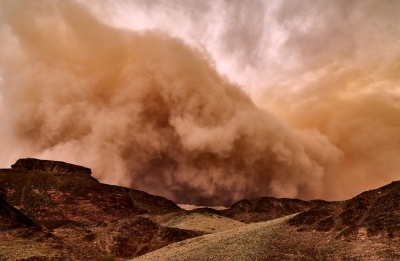
Sand and dust storms are common meteorological hazards in arid and semi-arid regions. They are usually caused by thunderstorms – or strong pressure gradients associated with cyclones – which increase wind speed over a wide area. These strong winds lift large amounts of sand and dust from bare, dry soils into the atmosphere, transporting them hundreds to thousands of kilometres away. Some 40% of aerosols in the troposphere (the lowest layer of Earth’s atmosphere) are dust particles from wind erosion. The main sources of these mineral dusts are the arid regions of Northern Africa, the Arabian Peninsula, Central Asia and China. Comparatively, Australia, America and South Africa make minor, but still important, contributions. Global estimates of dust emissions, mainly derived from simulation models, vary between one and three Gigatons per year.
Once released from the surface, dust particles are raised to higher levels of the troposphere by turbulent mixing and convective updrafts. They can then be transported by winds for lengths of time, depending on their size and meteorological conditions, before being pulled back down to the surface again. As larger particles sediment more quickly than smaller ones, there is a shift toward smaller particle sizes during transport. Dust is also washed out of the atmosphere by precipitation. The average lifetime of dust particles in the atmosphere ranges from a few hours for particles with a diameter larger than 10 ?m, to more than 10 days for the sub-micrometric ones.
Aerosols, particularly mineral dusts, impact weather as well as global and regional climate. Dust particles, especially if coated by pollution, act as condensation nuclei for warm cloud formation and as efficient ice nuclei agents for cold cloud generation. The ability of dust particles to serve as such depends on their size, shape and composition, which in turn depend on the nature of parent soils, emissions and transport processes. Modification of the microphysical composition of clouds changes their ability to absorb solar radiation, which indirectly affects the energy reaching the Earth’s surface. Dust particles also influence the growth of cloud droplets and ice crystals, thus affecting the amount and location of precipitation.
Airborne dust functions in a manner similar to the greenhouse effect: it absorbs and scatters solar radiation entering Earth’s atmosphere, reducing the amount reaching the surface, and absorbs long-wave radiation bouncing back up from the surface, re-emitting it in all directions. Again, the ability of dust particles to absorb solar radiation depends on their size, shape and mineralogical and chemical composition. The vertical distribution of dust in the air (vertical profile) and the characteristics of the underlying surface are also required to quantify this impact.
Credit : World Meteorological Organization
Picture Credit : Google




